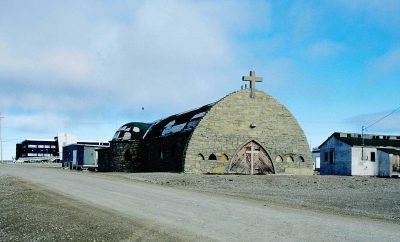Nunavut says goodbye to Kugaaruk’s stone church
Crumbling Roman Catholic church, built in 1940, deemed dangerous
Kugaaruk’s stone church, as it appeared in 2004, when it was photographed by Kelly Lewis. (Photo courtesy of Northernpix)
An historic landmark in Kugaaruk, its old stone church, has been demolished.
Two weeks ago, workers used a cherry picker lift to remove the cross and bell from the top of the church, which dated back to 1940.
Then the building was taken down, with these items and the rocks used in the construction of the church to be saved and stored in a special place.
Bishop Anthony Wieslaw Krotki of the Roman Catholic Diocese of Churchill-Hudson Bay said he was at first shocked by news of the church’s demolition.
“I learned about it the day after the church went down because I didn’t know anything about the plan,” he told Nunatsiaq News.
But Krotki soon learned that the demolition had been in the works for a while, he said, led by the hamlet, which had concerns about children in the community of about 1,000 who liked to play in and around it.
Krotki said rocks were falling off the steeple.
As a safety measure, the hamlet had put a fence up around the church and also surveyed people in the community about what the next step should be.
But the only way to remove the danger was to take the church down, Krotki said.
“I am pretty sure people in Kugaaruk were concerned about their children,” he said.
The church had not been used as a place of worship for years, but had been transformed into a museum.
“It was up to the community to decide [what to do with the church] because they had taken [over] the responsibility,” Krotki said.
A tiny stone building, which was the mission house from the 1940s, was left as “a sort of a reminder of what was there,” he said.
The hamlet said it had no comment to make on the decision to take down the church.
But many weighed in on Facebook, with one poster noting, “It is very sad. If the church had the funds I am sure it would have been rebuilt for historic purpose.”
Fathers Pierre Henri and Franz Van de Velde, called Ataata Vinivi in Inuktitut, built the stone church in 1941.
Later, the hamlet received a government grant to restore the deteriorating church as a historic site, but recently cement work from that renovation had started to fall apart.

This photo taken by Ansgar Walk in August 2002 shows the old St. Stephen’s stone church in Igloolik. (Photo courtesy of Wikimedia Commons)
In 2006, another of Nunavut’s stone churches, in Igloolik, was demolished.
Volunteers using dog teams had built St. Stephen’s Catholic Church in 1960. But it was torn down in 2006 because it also presented a safety hazard.
The church’s cornerstone was pulled from the rubble, and was to be preserved as a monument dedicated to those who built the church. Other rubble from the building was to be dropped in the ocean to reinforce the breakwater.

Ida Neglak sits in front of Cambridge Bay’s renovated old stone church at its official reopening ceremony in September 2014. (Photo by Jane George)
The stone church in the western Nunavut hub of Cambridge Bay almost met a similar fate after it was set on fire in 2006 and gutted by the blaze.
But, in 2014, the church celebrated its 60th anniversary—and its new roof—with a barbecue on Sept. 12, just two days shy of the anniversary date of its first mass: Sept. 14, 1954.
Father André Pierre Marie Steinmann, an Oblate missionary much better known for his years in northern Quebec, built Cambridge Bay’s church.
After Steinmann’s arrival from northern Quebec in 1953, he worked with local parishioners and two fellow missionaries, Fathers Lemer and Menez, to build the church.
They used seal oil and clay as mortar and broken rocks, which are plentiful around Cambridge Bay, for the walls.
Built for warmth, the church retained heat with an insulating layer of caribou fur between two layers of stone walls.
In 2014, the Cambridge Bay Coast Guard auxiliary was able to carry out $100,000 worth of renovation work. Some work still remains to be carried out.







Another monument to colonialism gone. Good.
Indeed.
Ataata Vinivi had a whole file or even a book on the history of that church building. He wrote that the wooden beam for the roof had been bought by Father Henry from the man who found it washed up upon the shore.
Father Henry was born in Brittany, France, where everyone had a house built of rocks.
But in the Arctic (and without seal oil as insulation, unknown in Brittany), this building must have been like a freezer in winter.
If you’ve followed the commentary of our MP on twitter recently you might notice a recurring theme; railing against colonialism and its symbols. Specifically, Mumilaaq has celebrated the tearing down of a statue to Canada’s First Prime Minister John A. Macdonald on a charge of racism.
.
An interesting and inescapable parallel comes to mind with the closure and deconstruction of these old churches across Nunavut. Certainly, the old stone church in Kugaaruk is not being closed for any of the same reasons, acknowledged. Yet to make similar charges against it would be valid, and perhaps even more so.
.
The missionaries who established and ran these outposts on the frontier were surely good people, most of the time, though not always. Yet regardless, their mission was one that was animated by the logic of ideological, cosmological, spiritual and by proxy racial superiority. This, to me, is not a controversial point to make, it seems obvious.
.
With that in mind, would our MP, or any of our cultural leaders who have called for the dismantling of the symbols of our past share the same sentiments with regards to the infrastructure of the church in Nunavut? And if not, why not?
I was in Cambridge during the building of the stone church. It troubles me to read in several publications the church being referred to as Fr. Steinmans church. Fr. Lemer traveled by dog team from Bathurst Inlet in the spring. He alone chose the site, cleared the site. laid the foundation, gathered the rocks, built the rock walls. Fr.s Steinman and Menez arrived
accidently sent info prior to finish
arrived in Cambridge in August and assisted with the completion. Primarily doing the woodwork.
Sad and shameful. I’m sure that the hamlet had no funds to maintain and stabilize this historic site. But I’m also sure that in a nation as rich as Canada, funds could have been found (government? private?) to preserve this building. Communities are trying to diversify their economies, and encouraging tourism is one way to do that. Yet tourists who spend time in communities complain that there s nothing to do and nothing “old” to see. A great interpretive tour (a walk and talk) could have been developed around this building and its history that could happily occupy a tourist and provide employment for a guide for a half-day. Every bit counts. Was GN Department of Culture etc asked if funds might be made available for preservation? Sad to see history being demolished. Some might complain that it is colonial history. That doesn’t matter. It’s history, and it’s gone. An irreparable loss.